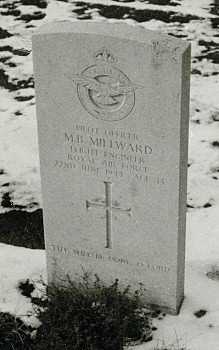LEATHERHEAD WAR MEMORIALS - WWII
Pilot Officer Maxwell Benjamin Millward RAFVR, Flight
Engineer
207 Squadron, 5 Group, RAF Bomber Command
Town Memorial World War II
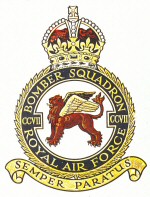
Semper Paratus (Always Prepared)
207 Squadron, 5 Group, RAF Bomber CommandLancaster ME827 EM-I was one of 21 Lancasters from 207 Squadron based at RAF Spilsby several miles inland from Skegness, Lincolnshire, which were tasked to take part in an attack on a hydrogenation (synthetic oil) plant at Wesseling near Cologne on the night of 21/22 June 1944. It took off at 2232hrs and crashed on the Moerstraatsebaan at Bergen-op-Zoom (Noord Brabant), Holland, where those who died are buried in the Canadian section of the local war cemetery. Max Millward was the Flight Engineer in the crew, on their 25th operation. Sgt Lloyd, a Navigator, was aboard to gain experience before his own crew began their tour, which was usually 30 operations.¹ |
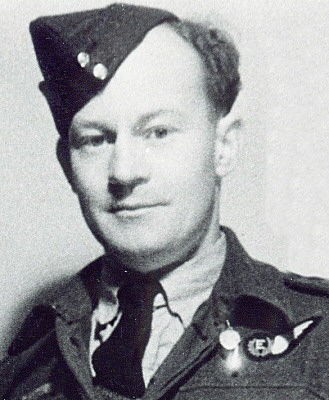 |
| Pilot | Flt Lt Frederick
Wootton Gallagher DSO RAFVR: Age 32: Date of Death: 22/06/1944
Service No 157083: Coll. grave 6. E. 2-7. Cemetery: BERGEN-OP-ZOOM CANADIAN WAR CEMETERY Son of Frederick Daniel and Alice Louise Gallagher; husband of Edna May Gallagher, of Nuneaton, Warwickshire, England. |
|||
| Flight Engineer |
|
|||
| Navigator | WO Alfred Young RAF: POW - Stalag Luft VII (Bankau-Kreulberg) pow nr 378 | |||
| Air Bomber | F/Sgt Ronald Parson
Scott RAFVR: Age 22: Date of Death: 22/06/1944 Service No: 1553209: Coll. grave 6. E. 2-7. Cemetery: BERGEN-OP-ZOOM CANADIAN WAR CEMETERY Son of Alexander Main Scott and Ada Julia Scott, of North Shields, Northumberland, England; husband of Marjorie Scott, of North Shields. |
|||
| Wireless Operator | F/O Peter William Ball
RAFVR: Age 22: Date of Death: 22/06/1944 Service No 169125: Coll. grave 6. E. 2-7. Cemetery: BERGEN-OP-ZOOM CANADIAN WAR CEMETERY Son of William George and Mabel Alice Ball, of Goodmayes, Essex, England. |
|||
| Mid Upper Gunner |
Sgt Kenneth Waddington
RAFVR: Age 20: Date of Death: 22/06/1944 Service No: 1622511: Coll. grave 6. E. 2-7. Cemetery: BERGEN-OP-ZOOM CANADIAN WAR CEMETERY Son of Wilfred and Hilda Waddington, of Intake, Sheffield, England. |
|||
| Rear Gunner |
WO Murray Sherman RCAF:
Age 21: Date of Death: 22/06/1944 Service No: R/144206: Grave 6. E. 1. Cemetery: BERGEN-OP-ZOOM CANADIAN WAR CEMETERY Son of David and Edna Sherman, of Toronto, Ontario. |
|||
| 2nd Navigator | Sgt Raymond William Lloyd RAFVR:
Age 22: Date of Death: 22/06/1944 Service No: 1399625: Coll. grave 6. E. 2-7. Cemetery: BERGEN-OP-ZOOM CANADIAN WAR CEMETERY Son of William and Lizzie Harriott Lloyd, of Edmonton, Middlesex, England. |
|||
RAFVR=Royal Air Force Volunteer Reserve: aircrew were volunteers.
Five of the 21 Lancasters from No.207 Squadron failed to return from this raid - 32 men were killed, three were taken prisoner and two - including the editor's father and his flight engineer - evaded capture.
WESSELING 21/22 June 1944
133 Lancasters and 6 Mosquitos attacked the synthetic oil plant at Wesseling. All the aircraft, bar five Lancasters from 1 Group, were from No.5 Group.
The weather forecast for the target area predicted clear conditions but the bombing force encountered 10/10ths low cloud. The planned 5 Group low-level marking method could not be used and the reserve method, in which the Lancasters bombed using their H2S air to ground radar was used instead. German night fighters made early contact with the bomber stream in high visibility conditions on the way to and from the target and 37 Lancasters were lost, Nos.44, 49 and 619 Squadrons each losing six aircraft. The casualty rate was 27.8% of the Lancaster force, more than exceptionally high at this stage of the war.
Post raid reconnaissance showed that only slight damage was caused to the oil plant and this is borne out by a local German report which adds that 15 Germans, 5 foreign workers and 1 prisoner of war were killed in the nearby town of Wesseling. But a secret German report quoted in the British Official History Vol IV, p323 records a 40% production loss at Wesseling after this raid. It is possible that this loss was of only short duration.²
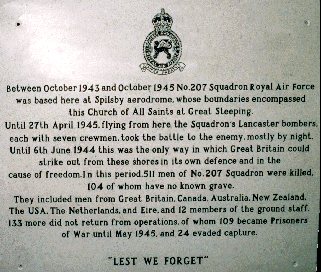
Plaque to 207 Squadron in All Saints' Great Steeping,
the church on the boundary of RAF Spilsby
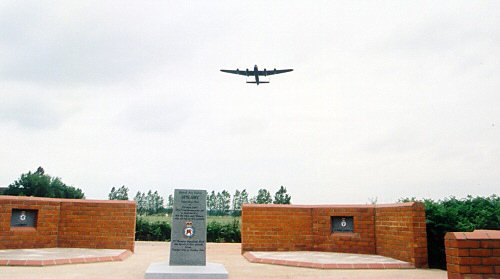
The Memorial Flight Lancaster salutes the 207 Squadron memorial
dedicated in 2001 at the site of RAF Spilsby.
Weathering caused this memorial to deteriorate and it was replaced
by one in Portland Stone in 2012.
Sources
1. RAF
Bomber Command Losses of the Second World War, volume for 1944
(WR Chorley)
2. Bomber Command War Diaries 1939-45
(Middlebrook & Everitt) and post raid report, 207 Squadron
Photo: Terry Millward/207 Squadron Archive
Links
Commonwealth War Graves Commission entry
207 Squadron RAF Association website
Location of Moerstraatsebaan, Bergen-op-Zoom, where the aircraft crashed
Map of the Spilsby area - Map of the Great Steeping/airfield area (a few faint traces can be seen) - Memorial location map
Terry Millward, Max's son recalls: my grandparents, Mr and Mrs H.G. Kimberley, came from Wolverhampton just after the First World War. Grandfather Kimberley had been a prison camp commandant in Sussex and decided that the South would be a more healthy environment for the family - wife, two sons and two daughters. He had been in manufacturing in the Midlands and was also an accomplished organist, largely self taught.
For many years grandfather Kimberley conducted the Leatherhead Choral Society. In the Second World War he was Warden at the underground shelter under what is now the gruesome shopping development on Swan Corner opposite the end of Church Street.
Grandfather Kimberley opened a garage in Church Street, just below the Parish Church. He ran this with Bernard, his second son. Unfortunately the garage closed on Sundays when all the bright young things were cruising down the A24 in their Bentleys, and the business went bankrupt!! Grandfather closed the garage on Sundays because he was organist at All Saints, and because Bernard, who later ran his own motor bike business, liked to race machines at various tracks round south London. As early as about 1930, my mother applied to the authorities to be his racing sidecar passenger, but was refused!
My mother, Joyce Millward, née Kimberley, drove the taxi they operated, and was one of the first women drivers in Leatherhead. My mother lived with my grandparents at 20 (now number 7) Kingston Avenue, until she married father in 1936. Mother and father met in the church choir - where else in this family?
My father, Max Millward, came from Byfleet. His parents were Benjamin and Lillian Millward. Grandfather Millward had been Lord Beaverbrook's chauffeur and Beaverbrook was my father's godfather. Grandfather Millward was a bit of a rogue, but that's another story.
After they married my mother and father lived in Sunmead Close, Fetcham, just behind where the bus garage was. My father Max was also a keen motor cyclist and before joining the RAF he was with Uncle Bernard in the Home Guard. Bernard Kimberley, although he had been in WWI, went back into the REME as an officer. His house at the top of Copthorne Road was actually bombed and demolished.
On Thursday June 22nd 1944, my mother and I were staying in Skegness, near RAF Spilsby. We were there in order to see my father. A WAAF came to the boarding house to tell my mother he was missing.
We left Sunmead Close and my mother went back to live at Kingston Avenue. In my boyhood our neighbours in the Kingston Avenue house were the Gordon Clark family. Gordon Clark was a County Court judge, who wrote elegant crime novels under the pseudonym of Cyril Hare. The Gordon Clarks were very kind to me and I became engaged to their daughter, Sandra, at the age of six. Tragically, the affair did not last, and she is now Lady Wedgwood. Oh, what she missed! She is related by marriage to the Darwins, Huxleys, Vaughan-Williamses, amongst others. I should love to remind her of her first youthful indiscretion.
My mother undertook a variety of jobs. She was steered towards one by the RAF Benevolent Society, I believe, as assistant matron at a boys' boarding school in Felixstowe. I went as part of the package. An interesting school. Later on, the headmaster, a 'Captain' (who had a bachelor clergyman brother of similar bent) went to prison for five years. Even as a six-year old boy I used to wonder why he used to tuck us up in bed at nights. Needless to say mother did not stay long.
After a number of clerical and teaching jobs, she became school secretary at City of London Freemen's School, to my slight embarrassment as I was a pupil there. A somewhat embarrassing interview was set up between Beaverbrook and me when a rather pushy relative heard I was interested in going into journalism after leaving City of London Freemen's. For a long time my mother was practice manager at the surgery opposite the Crescent Cinema, now the Theatre, of Drs. Everett, Gavin, Williams, and Benson, to name the principal partners in those days. Another typical Leatherhead twist was that Alan Everett, a much-loved character, was also Lord Beaverbrook's private physician, and after retirement he lived in a house on the old devil's Cherkley estate. Mother and I moved into the flat above the surgery, behind the parade of shops in about 1958. The Rossiters, who ran a stationery shop, were particularly friendly.
Mother finally remarried in 1970 and left Leatherhead for good, though she had been living with friends in Newdigate for a couple of years; she died in 2004. My wife Rosalind's father was Henry Killick. Henry was a solicitor and also a local councillor, and he was Chairman of the Leatherhead Urban District Council during the sixties. He captained Leatherhead Cricket Club at one time. He was also a Lay Reader and a general all-round 'good egg', as PG Wodehouse would have said. Tragically Henry Killick developed Parkinson's at around the time Rosalind and I were married in 1965. The Killicks lived at Chesters, in Linden Gardens, where they virtually backed on to the family home of Susan Sturt, better known later as Susan Howatch. The Killicks moved to Ropley, near Alton.
Just one final bit of local genealogy - Rosalind's mother's parents were the Rivingtons. Her father was another lawyer who had set up the College of Law in Guildford. They lived in a large house, Bedwyn, in St.Nicholas Hill. The house was still there in 1999, though the garden has been built on. Terry concludes - "Strange is the effect of a small-town boyhood - and it was small in those days!"
the website editor would like to add further information on this casualty
last updated 17 Jul 05: 12 Feb 14 CWGC links updated 7
Nov 17
